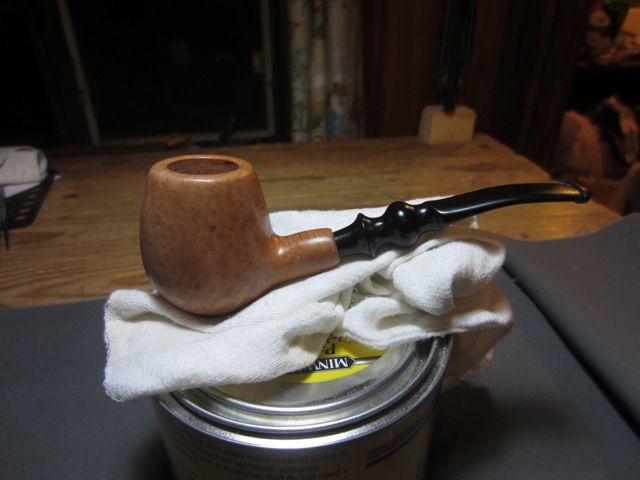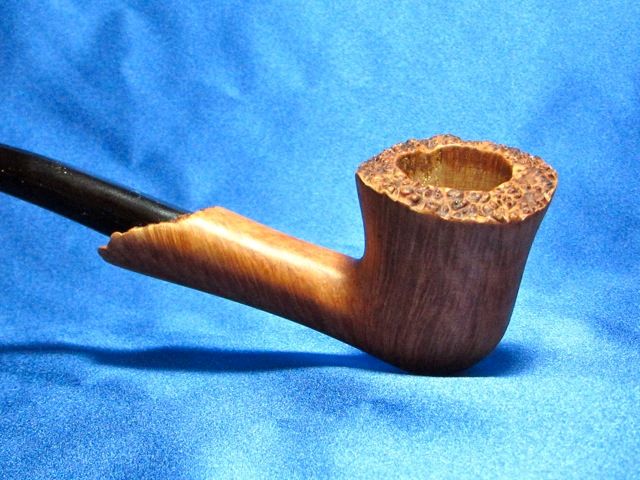What is Birdseye Exactly?
- Thread starter kendodan
- Start date
You are using an out of date browser. It may not display this or other websites correctly.
You should upgrade or use an alternative browser.
You should upgrade or use an alternative browser.
SmokingPipes.com Updates
Watch for Updates Twice a Week
- Status
- Not open for further replies.
It would certainly be more sought after by me. I see so many briars with that bird's eye type of grain on one side of the pipe and straight grain on the other, and it makes me wish I could find a pipe equally beautiful on both sides. No doubt I would pay a Premium for a pipe with a grain pattern like that pictured above.
I started with rusticated pipes, anglesey, and now tend toward the smooth finishes, precisely for the beauty of the grain. Apparently I could give a fiddlers fart!
I'll chime in with my idea on Birdseye. I don't think it as a type of grain, but rather how you are looking at the grain. Most of the time we see the grain as long lines in the pipe. Some take those lines that are parallel and close together as "straight grain". Imagine looking at the tops of those grains. A visual might be holding a bunch of straws in a bundle, if you look at the straws standing up a nice tight group, straight grain. If you look down on the straws you see a bunch of holes- voila birdseye.
Correct me if I'm wrong, but usually, if you had a nice straight grain running vertically up the bowl, you'd find a lot of great Birdseye On the bottom of the bottom of the bowl right? Almost like it's the "root" of the grain?
I never liked it for a long time, but it's growing on me now
I never liked it for a long time, but it's growing on me now
From pipe videos and online retail, it appears to me that birds eye grain, the little round patterns with centers, most
often occurs on one side of a briar bowl, with a straight grain pattern showing up on the other, and this is a standard
characteristic of many pieces of briar, not a defect or disappointment. Other briar has the straight grain on both sides
of the bowl. Someone who handles the raw briar and actually carves the pipes can probably correct or enlighten me
further.
often occurs on one side of a briar bowl, with a straight grain pattern showing up on the other, and this is a standard
characteristic of many pieces of briar, not a defect or disappointment. Other briar has the straight grain on both sides
of the bowl. Someone who handles the raw briar and actually carves the pipes can probably correct or enlighten me
further.
It's the cross section of the grain. Lets say that you have a bowl with even straight grain flowing top to bottom around the sides. The rim of the bowl and the bottom would show a cross section of that grain and the cross section would be birdseye. It the bowl was cross cut, with the grain flowing horizontally across the front and back sides of the bowl, then you would get birdseye left and right.So it's basically just the grain is swirling?
Since grain is not even, nor does it often flow straight, there are many variations on how the wood grain interacts with the shaping of the bowl. So, even with an east/west cross cut, you might get very little birdseye, or loose barely present birdseye. You are more likely go get birdseye with straight grain or flame grain wood.
I've two Castellos that are literally covered from head to toe with birdseye, which means that the grain is flaring out in all directions thus allowing for the bowl shape to capture that cross section across all angles.
Sablebrush hit the nail on the head. Because the grain is not uniform from briar block to briar block, it take a lot of skill to get a perfect straight grain pipe, thus the high cost usually follows. Also, in general terms, plateau briar will offer a more uniformed grain that an ebauchon will since plateau briar is cut from the outer edge of the burial and the ebauchon will come from the center.
Birdseye is the end grain. It is also a brand of frozen vegetables. As long as the grain is tight it doesn't matter if it is straight or birdseye. A perfect straight grain costs more.
So, the vegetables cost less?Birdseye is the end grain. It is also a brand of frozen vegetables. As long as the grain is tight it doesn't matter if it is straight or birdseye. A perfect straight grain costs more.
I think some of the obscurity about birdseye grain comes from the fact that, in regular lumber, "birdseye" is a figure that occurs when you have a lot of tiny knots widely distributed over a board, most commonly in "birdseye maple." In briar, however, what we call "birdseye" is a pretty normal property of the burl from which the pipes are made.
If you look closely at just about any smooth briar pipe, you'll probably see birdseye figure somewhere, depending on how the original burl was cut. In a pipe made from "ebuchon" briar, you'll often find the birdseye figure on the sides, though it will probably be more prominent on one side than on the other. In a pipe made from "plateaux" briar, you'll find the birdseye on the top or bottom, and often both. In general, blocks cut from the top, or the outside of the burl tend to be cut as plateaux blocks, whereas pipes cut from the inside tend to be cut as ebuchon blocks. But what normally distinguishes ebuchon from plateaux is the orientation of the grain. I'm oversimplifying a little bit here, as briar cutting is an art in itself, but that's the gist of it.
So, for example, here's a pipe I made some time ago (yeah, I know, not a great looking one, but I'm still a novice) from ebuchon briar, and you can see a bit of birdseye on the side:

Here's one I made from plateaux:

Notice the vertical lines in the grain. The lines terminate in the little bumps on the top of the pipe. If you remove that natural surface, you reveal the birdseye grain underneath.
Because we're dealing with a natural substance here, there is a lot of variation in the appearance of the birds' eyes from one block of wood to another. Naturally, the ones with tighter, more vivid figure sell for a premium and tend to find their way into pipes that also sell for a premium.
If you look closely at just about any smooth briar pipe, you'll probably see birdseye figure somewhere, depending on how the original burl was cut. In a pipe made from "ebuchon" briar, you'll often find the birdseye figure on the sides, though it will probably be more prominent on one side than on the other. In a pipe made from "plateaux" briar, you'll find the birdseye on the top or bottom, and often both. In general, blocks cut from the top, or the outside of the burl tend to be cut as plateaux blocks, whereas pipes cut from the inside tend to be cut as ebuchon blocks. But what normally distinguishes ebuchon from plateaux is the orientation of the grain. I'm oversimplifying a little bit here, as briar cutting is an art in itself, but that's the gist of it.
So, for example, here's a pipe I made some time ago (yeah, I know, not a great looking one, but I'm still a novice) from ebuchon briar, and you can see a bit of birdseye on the side:

Here's one I made from plateaux:

Notice the vertical lines in the grain. The lines terminate in the little bumps on the top of the pipe. If you remove that natural surface, you reveal the birdseye grain underneath.
Because we're dealing with a natural substance here, there is a lot of variation in the appearance of the birds' eyes from one block of wood to another. Naturally, the ones with tighter, more vivid figure sell for a premium and tend to find their way into pipes that also sell for a premium.
- Status
- Not open for further replies.









